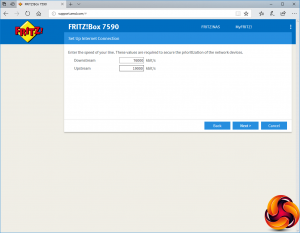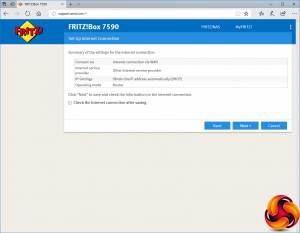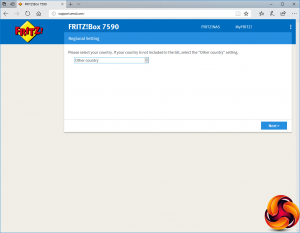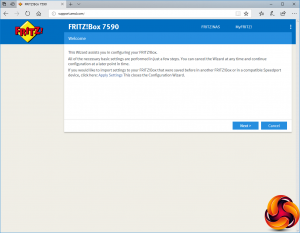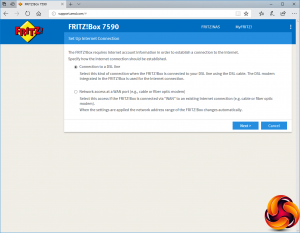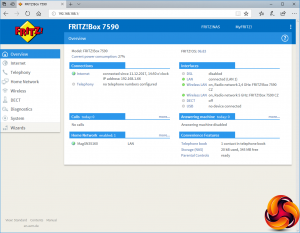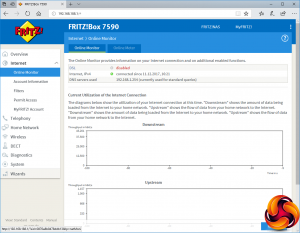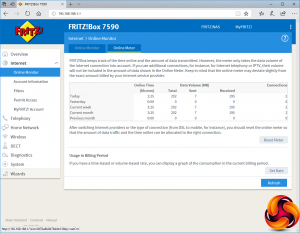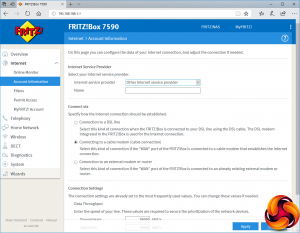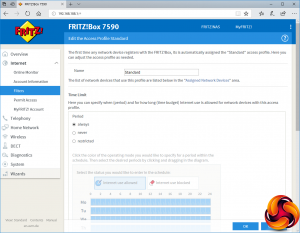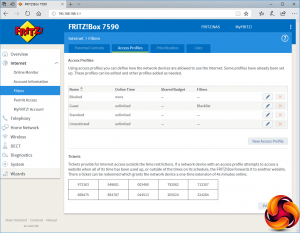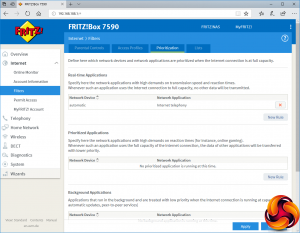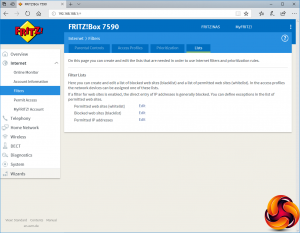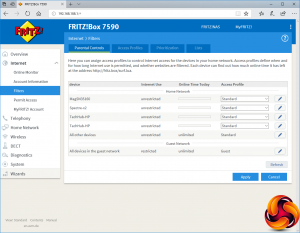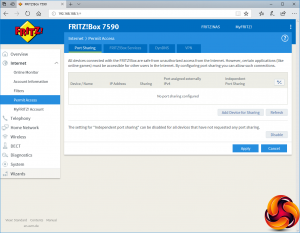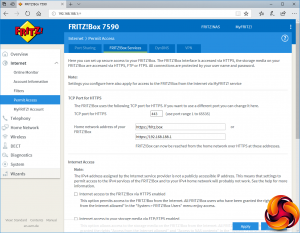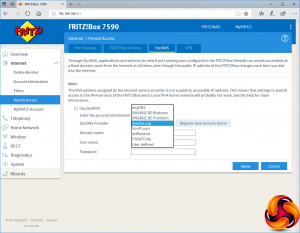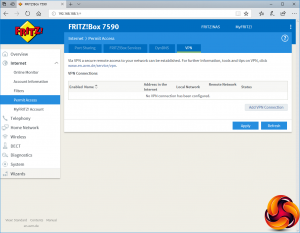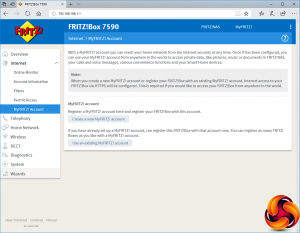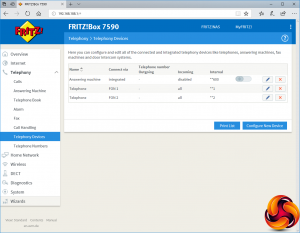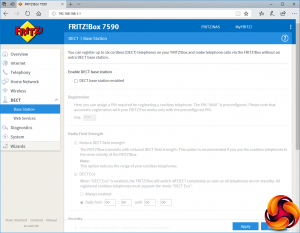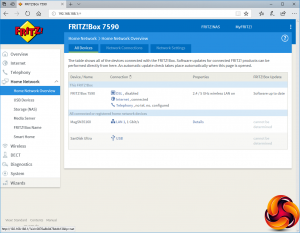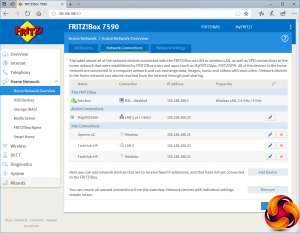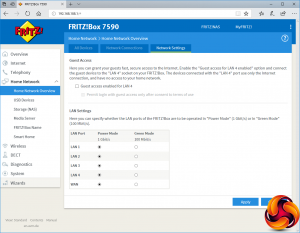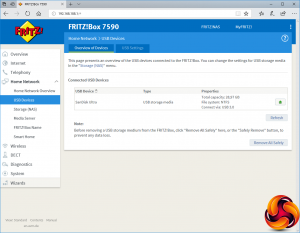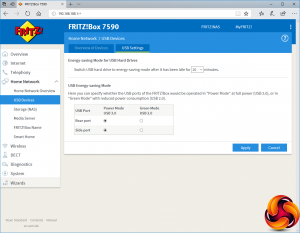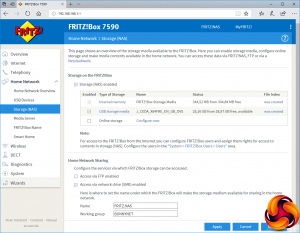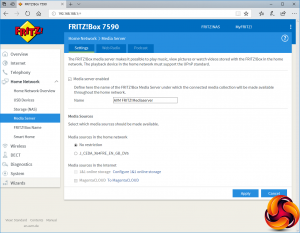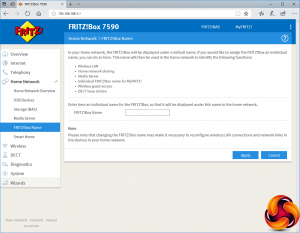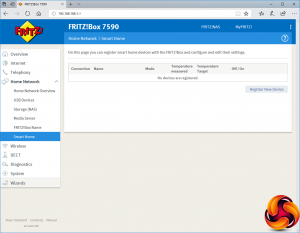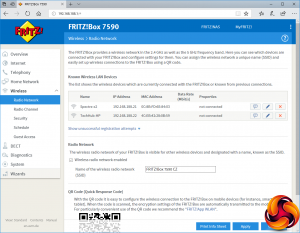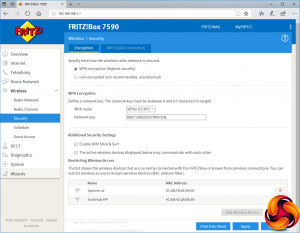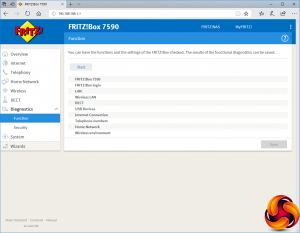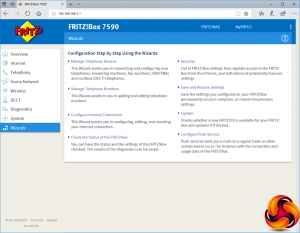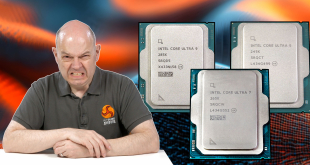Loading a Web browser takes you through a short setup wizard, which starts by setting your country. This then lets you choose which of the two broadband connection types you will be using and the associated line speed, after which it saves your setting.
The initial screen of the Web interface is an overview. This is the calm before the storm, however, because as the Interfaces area hints, there is a huge amount of functionality available.
The Internet section contains an exhaustive set of tools for assessing and configuring the Internet connection, starting with a real-time Online Monitor and historic Online Meter of bandwidth consumption. You can also adjust the broadband connection type and settings, switching from WAN to DSL.
Parental controls are truly extensive, going beyond what virtually every other router we have tested offers. Particularly handy is the ability to group devices into access profiles, and also define a profile for guest devices. This primarily revolves around setting hours when the Internet is available, but you can also enforce a policy blocking certain websites for each profile based on a blacklist, or restrict access only to certain websites by whitelist.
There's even a ticket system where devices can be given a code allowing an extra 45 minutes of online time. There's an extensive ability to prioritise certain applications over others across the network, and balance usage between Internet access and purely internal network usage.
The Lists section is where you define the whitelist, blacklist and permitted IP addresses. These are all global, however. You can't have multiple lists in each type, and no templates are provided for either. You will need to build these from scratch or download one that is publicly maintained.
The 7590 has the usual ability to share certain ports on local devices over the Internet, primarily for online gaming. The FRITZ!Box Services section is rather unique, in that it allows 7590 to be accessed only via HTTPS. It has its own certificate that you can download to devices, otherwise they won't be allowed access. You can also import your own existing digital certificate. To facilitate external access over the Internet, a comprehensive array of dynamic DNS services is supported.
There's also comprehensive VPN support, either from one FRITZ!Box to another, on a single-user basis, or via a company or existing VPN service. These are very powerful capabilities, and one reason why AVM's routers are popular with businesses. The MyFRITZ! account lets you access your home network remotely, including NAS storage attached to the FRITZ!Box, voice messages on the telephony system, and Smart Home functions.
The telephony functions are unique amongst any wireless router we have tested recently. You can connect the 7590 either to an existing landline or use pure IP telephony, with direct support for SIP provider sipgate, SIP DDI and trunking, or a custom IP telephony service. Once this is set up, you can give the two built-in analog lines extension numbers or direct lines. There's a call log for telephony activity, up to five built-in answering machines, and a shared phone book you can add numbers to via the Web administration interface.
You can set up to three alarms, so that a local handset will ring to notify you or wake you up at a fixed time, which can even be on a daily basis for certain days of the week. The system can receive faxes and then send them as images to USB-connected storage or via email. You can set up rules for blocking numbers, diverting them, plus dialling rules, and even add carrier prefixes for specific categories of number, which are useful if you have a special carrier for international calls, for example.
If you turn on the DECT base station, up to six wireless handsets can be added to the system and all the above features then used with them, turning the 7590 into a really powerful telephony hub.
The Home Network section is where you configure the local services like the 7590's built-in NAS storage and media servers, plus the IP addresses being doled out to local devices. You can set the Ethernet ports at either Gigabit speed, or Fast Ethernet to save power consumption. Similarly, USB storage can run at either USB 3.0 or 2.0 to save power.
Once you have plugged in a USB device, you need to create the file index to make it available. This doesn't delete any data, just adds some index folders. You can then share the storage over the network.
There's a built-in UPnP media server, which can also share Web Radio stations and downloaded podcasts. Interestingly, you can even use this server to share 1&1 and MagentaCLOUD online media storage to the local network. You can also use this section to change the local network name of the 7590 from the default.
One area we were not able to test due to not having any compatible devices was the Smart Home functionality. AVM sells a variety of DECT-connected smart home devices, including a radiator control (FRITZ!DECT 301), a power outlet control (FRITZ!DECT 200) and a power outlet control with consumption measurement (FRITZ!DECT 210).
However, only the radiator control would be worth using in the UK, as the other two are focused on European power plugs, although you could use adapters.
The Wireless section is where you configure the WiFi radios and connected devices. You can change the SSID and use a QR code to connect up smartphones quickly. You can change the network key and decide whether wireless devices can talk to each other, or just to the Internet and wired LAN devices. You can manually configure the wireless channels used, schedule when the WiFi is on during the day, and set up a guest WiFi so that visitors are kept separate from permanent users.
The Diagnostics section lets you run a huge set of tests to make sure everything is operating smoothly. There's also an array of tools for monitoring the Internet connection for potentially stray activity that could signal a hacking attempt.
Finally, the Wizards section provides simplified routines to help you set up key features, such as adding telephony devices and numbers, configuring the Internet connection, checking status and security, updating the device, and configuring push notifications for various events.
From the length of this section of the review, it should be clear that the FRITZ!Box 7590 is incredibly feature-rich. In fact, we would go so far as to say this is the most feature-rich router we have ever tested. There is nothing we can think of that isn't available, and AVM has also shown its experience by managing to present a lot in such a way that it doesn't feel like an overly complicated avalanche of settings you will never be able to understand.
The Wizards make setting up unique features like telephony quite a bit easier, although it will still take some playing to get the most out of what's available, which is inevitable with so much on offer. However, lots of router features are only worth having if there's WiFi performance to match, so next let's turn to this aspect.
 KitGuru KitGuru.net – Tech News | Hardware News | Hardware Reviews | IOS | Mobile | Gaming | Graphics Cards
KitGuru KitGuru.net – Tech News | Hardware News | Hardware Reviews | IOS | Mobile | Gaming | Graphics Cards


